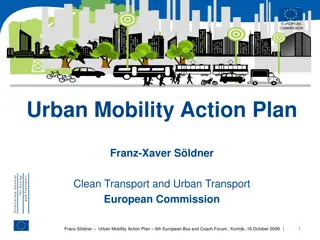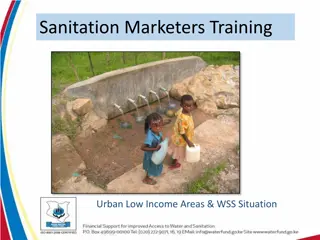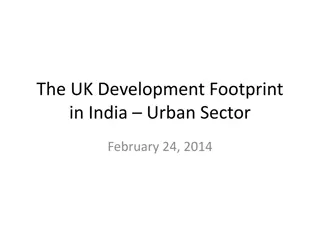Urban Ecosystem and Environmental Resources Management
Explore the intricacies of managing urban ecosystems and environmental resources, including solid waste, wastewater, and gaseous emissions treatment systems. Discover the interconnectedness between cities and their surrounding natural landscapes, and the importance of sustainable practices in maintaining environmental quality amidst urbanization.
Download Presentation

Please find below an Image/Link to download the presentation.
The content on the website is provided AS IS for your information and personal use only. It may not be sold, licensed, or shared on other websites without obtaining consent from the author. Download presentation by click this link. If you encounter any issues during the download, it is possible that the publisher has removed the file from their server.
E N D
Presentation Transcript
Course 3.1, Section IV Urban Ecosystem and Environmental Resources Module 3: Solid waste, Wastewater and Gaseous Emissions Treatment Systems Course 3.1 Environmental Science and Technology for Decision Makers Developed by AIT for Tongji University
Recap from the Last Lecture: City as a System Cities as Engineered System Different from Natural Ecosystem Concept of Greener Cities Require less import from outside Reducing export to outside Mid-Term Examination How was examination? Feedback 2 Module 3: Solid waste, Wastewater and Gaseous Emissions Treatment Systems
Urban Ecosystem and Environmental Resources
City Life: In past, emphasis of environmental action on Wilderness Wildlife Endangered species Impact of pollution on natural landscapes outside cities Cities Thought of as polluted, dirty, lacking in wildlife & native plants, ARTIFICIAL Therefore BAD Wilderness Thought of as unpolluted, clean, full of wildlife & native plants, NATURAL Therefore GOOD 4 Module 3: Solid waste, Wastewater and Gaseous Emissions Treatment Systems
City Life: Majority of people live in URBAN environments Have suffered directly from their decline Yet LITTLE public concern on URBAN ECOLOGY City Dwellers Center of some most important environmental issues City & Wilderness inextricably connected Re-BIRTH of interest in URBAN ENVIRONMENT URBAN ECOLOGY MEGA-CITIES Huge metropolitan areas cropping up more & more In FUTURE, most people will live in cities For most people, living in an environment of good quality mean living in a city that is managed carefully to maintain that ENVIRONMENTAL QUALITY 5 Module 3: Solid waste, Wastewater and Gaseous Emissions Treatment Systems
Sustaining Life on Earth... Natural Ecosystem 6 Module 3: Solid waste, Wastewater and Gaseous Emissions Treatment Systems
City as a System 7 Module 3: Solid waste, Wastewater and Gaseous Emissions Treatment Systems
City as a System A City Not a self-contained ecosystem Depends on other cities & rural areas A city takes in raw materials from surrounding countryside Food Water Wood Energy Mineral Ores everything that a human society uses A City produces & exports material goods (Value Added Goods?) Export ideas Innovations Inventions Arts Spirit of civilization A City cannot exist without a countryside to support it 8 Module 3: Solid waste, Wastewater and Gaseous Emissions Treatment Systems
City - Surroundings: as a System If environment of a city declines, almost certainly environment of its surroundings also declines Reverse also true if environment around a city declines, city itself be threatened 9 Module 3: Solid waste, Wastewater and Gaseous Emissions Treatment Systems
City - Surroundings: as a System Cities export waste products to countryside Polluted Water Polluted Air Waste Solids Annual Resource Use & Waste Produced by city resident If EXPORTED without CARE, pollute countryside Reducing its ability to provide necessary resources for city Making life in surroundings less healthy & less pleasant 10 Module 3: Solid waste, Wastewater and Gaseous Emissions Treatment Systems
City - Surroundings: Interactions Often STRAINED RELATIONSHIP between people living in cities and countryside!!! Why country dwellers have to deal with wastes of those in the city? Answer: Many serious environmental problems occur at INTERFACE between URBAN and RURAL areas (Vested) Interest of People living outside but near to City in maintaining A good environment for city A good system for managing city's resources More concentrated the human population in city, MORE land available for other uses (wilderness, recreation, conservation of biological diversity, production of renewable resources So CITIES benefits wilderness, rural areas & so forth 11 Module 3: Solid waste, Wastewater and Gaseous Emissions Treatment Systems
Densely Populated Cities People to live in densely populated cities, ways needed To make urban life healthy and pleasant To keep cities from polluting very environment that dense human population in theory frees for other uses City planners found ways to make cities pleasing: Developing parks & connecting cities in environmentally & aesthetically pleasing ways to rivers and nearby mountains Long experience in city planning combined with modern knowledge from environmental science make cities of future healthier, more satisfying to people and better integrated within the environment Beautiful cities not only healthy but attract people, Relieving pressures on the countryside 12 Module 3: Solid waste, Wastewater and Gaseous Emissions Treatment Systems
The City as an Environment A city changes the landscape Also changes relationship between biological and physical aspects of environment ENERGY BUDGET of a city Like any ecological & environmental system, city also has an "energy budget City exchanges energy with its environment o absorption and reflection of solar energy o evaporation of water o conduction of air o winds (air convection) o transport of fuels into & burning of fuels by people within city o convection of water (subsurface & surface steam flow) In turn affect climate within city, city may affect climate in nearby surroundings - a possible landscape effect 13 Module 3: Solid waste, Wastewater and Gaseous Emissions Treatment Systems
The City as an Environment URBAN ATMOSPHERE AND CLIMATE Cities affect local climate o As city changes, so does its climate Cities generally less windy and non-urban areas o Buildings & other structures obstruct flow of air o Buildings also channel wind - creating local wind tunnels with high wind speeds City typically receives less sunlight than countryside o because of particulates in atmosphere over cities o >10 times more particulates in urban areas than surrounding areas o in spite of reduced sunlight, cities warmer than o surrounding areas for two reasons Increased heat from burning of fossil fuels Lower rate of heat loss, partly buildings & paving materials act as solar collector 14 Module 3: Solid waste, Wastewater and Gaseous Emissions Treatment Systems
The City as an Environment Urban Atmosphere and Climate 15 Module 3: Solid waste, Wastewater and Gaseous Emissions Treatment Systems
The City as an Environment SOLAR ENERGY IN CITIES Common to use solar energy to help heat city houses o Cheap & easily accessible fossil fuels led to forget it Ancient cities designed to use passive solar energy Today, importance of solar energy back o solar photovoltaic devices common sight in cities o some cities enacted solar energy ordinances to make it illegal to shade another property owner's building in such a way that it lose solar heating capability 16 Module 3: Solid waste, Wastewater and Gaseous Emissions Treatment Systems
The City as an Environment Water in Urban Environment Modern cities affect WATER CYCLE In turn affecting soils & consequently plants and animals Paved streets & buildings prevent water infiltration Most rain runs off into storm sewers Paved streets & sidewalks prevent water in soil from evaporating to atmosphere o Process that cools natural ecosystems o Adds to urban heat island effect Flooding within City and downstream outside city 17 Module 3: Solid waste, Wastewater and Gaseous Emissions Treatment Systems
The City as an Environment Water in Urban Environment Planned better drainage in city area 18 Module 3: Solid waste, Wastewater and Gaseous Emissions Treatment Systems
The City as an Environment Soils in City Modern cities have great impact on SOILS o Soil covered by cement, asphalt, stone o Soil no longer has natural cover of vegetation o Natural exchange of gases between soil and air greatly reduced o Soils lose organic matter as no longer replenished by vegetation growth o Soil organisms die from lack of food & oxygen In addition, construction process & weight of buildings compact the SOIL o Restricts water flow o Lead to waterlogging, impervious to water flow Made Land: Lands created from fill o Not suited for foundation of buildings 19 Module 3: Solid waste, Wastewater and Gaseous Emissions Treatment Systems
The City as an Environment Pollution in City In a City, everything concentrated o Including POLLUTANTS City Dwellers exposed to o More kinds of toxic chemicals in higher concn o More human-produced noise, heat & particulates o Makes life RISKIER Urban Pollution comes from o Motor vehicles (lead in gasoline?) o Nox, CO from exhaust o Home heating gives particulate, sox, nox o Industries gives variety of chemical pollutants Exposure be reduced by o Placing houses & recreation areas away from roads o Developing a buffer zone using trees 20 Module 3: Solid waste, Wastewater and Gaseous Emissions Treatment Systems
Thank You 21 Module 3: Solid waste, Wastewater and Gaseous Emissions Treatment Systems























